Misen Knife Set Review: Unlocking Culinary Excellence at an Honest Price
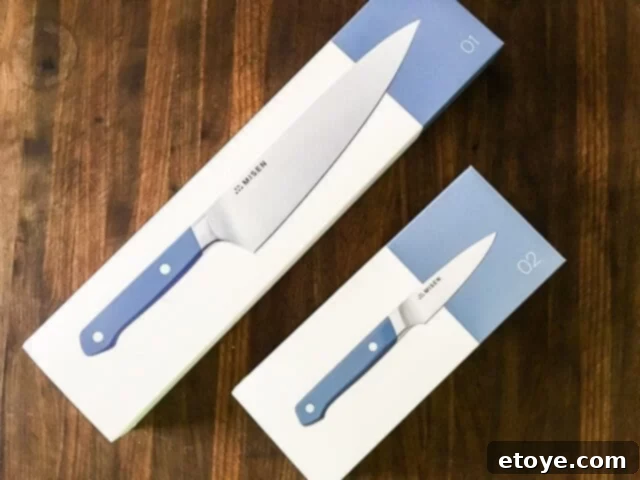
In the vast world of kitchen essentials, a reliable set of knives stands paramount. For home cooks and culinary enthusiasts alike, the quest for tools that balance performance with affordability often feels like searching for a needle in a haystack. Enter Misen, a brand that set out to disrupt the traditional knife market by offering professional-grade quality without the prohibitive price tag. This comprehensive review delves into the Misen Knife Set, examining both its renowned Chef’s Knife and its indispensable Paring Knife, after extensive real-world use. We’ll explore what makes these knives a game-changer, from their innovative design and material science to their long-term durability and exceptional value.
Misen’s Vision: Quality Knives, Direct to Your Kitchen
The story of Misen began in September 2015 with a remarkably successful Kickstarter campaign, where they raised over $1 million. Their ambitious goal was clear: to deliver a high-quality chef’s knife directly to consumers at an “honest price.” This direct-to-consumer model is Misen’s secret sauce, allowing them to bypass the exorbitant markups associated with traditional retail channels. When you walk into high-end kitchen stores, you’re often paying not just for the knife itself, but for marketing campaigns, product placement fees, and a complex chain of wholesalers and retailers. Misen’s streamlined approach fundamentally alters this equation, enabling them to offer a premium chef’s knife for just $65 and a paring knife for $30 – prices that comfortably rival competitors charging two to three times more for similar quality.
Misen’s philosophy revolves around the idea that exceptional kitchen tools should be accessible to everyone, not just professional chefs or those with deep pockets. They focus on intelligent design, high-quality materials, and efficient distribution to deliver superior performance directly into the hands of passionate home cooks. This commitment to value and quality has quickly established Misen as a beloved brand in the culinary community.
Understanding Misen Knife Material: The Heart of Performance
The foundation of any great knife lies in its steel, and Misen opts for Japanese AUS-8 High Carbon Steel. This material is a thoughtfully chosen alloy, known for its balanced properties. Importantly, AUS-8 steel includes vanadium, an element that significantly improves wear resistance, enhances toughness, and remarkably, makes the steel easier to sharpen. As detailed by experts at BladeHQ, vanadium is a key contributor to a knife’s longevity and user-friendliness.
While AUS-8 may not be the most exotic steel available, it strikes an impressive balance between crucial attributes: durability, ease of sharpening, and resistance to rust. It’s a robust, mid-grade material widely utilized in many reputable Japanese kitchen knives, offering reliable performance for everyday cooking tasks. For the vast majority of home cooks, this balance is precisely what makes Misen knives so practical and dependable.
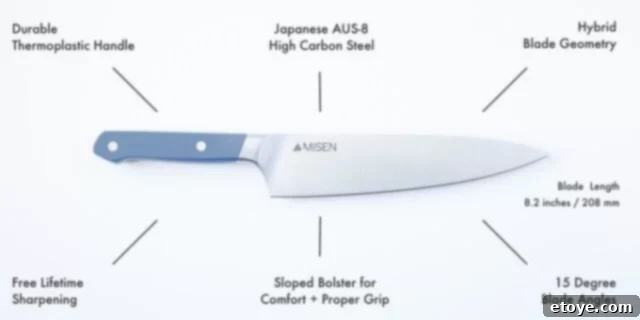
Misen further optimizes its knives through meticulous tempering, achieving a Rockwell hardness of 58-59º. To understand why this is a “sweet spot,” consider the spectrum of knife hardness. Higher Rockwell numbers generally indicate harder steel, which means better edge retention and durability. However, excessively hard steel can also be more brittle, prone to chipping or shattering if dropped on a hard surface or used for inappropriate tasks like whacking through bones – a lesson learned the hard way by many with ultra-thin, high-end Japanese knives tempered at 60-61º. Conversely, steel that is too soft dulls quickly, requiring constant sharpening.
The 58-59º Rockwell rating chosen by Misen represents an intelligent compromise. It’s hard enough to hold a sharp edge through extended use but flexible enough to resist chipping during common kitchen mishaps. This means you get a knife that stays sharp longer than softer alternatives, yet is significantly easier to sharpen and maintain than ultra-hard variants. For the home cook, this translates into less time sharpening and more time enjoying the act of cooking, without the constant worry of damaging a delicate blade.
The Misen Chef’s Knife: A Seven-Month Update on Performance and Comfort
After seven months of rigorous use, the Misen Chef’s Knife has not only earned its permanent place in my knife drawer but has become the go-to blade for tackling substantial prep work. When faced with mountains of produce – be it pounds of vegetables for a stir-fry or multiple heads of cabbage for slaw – this is the knife I instinctively reach for. The primary reason for its favored status? Unparalleled comfort.
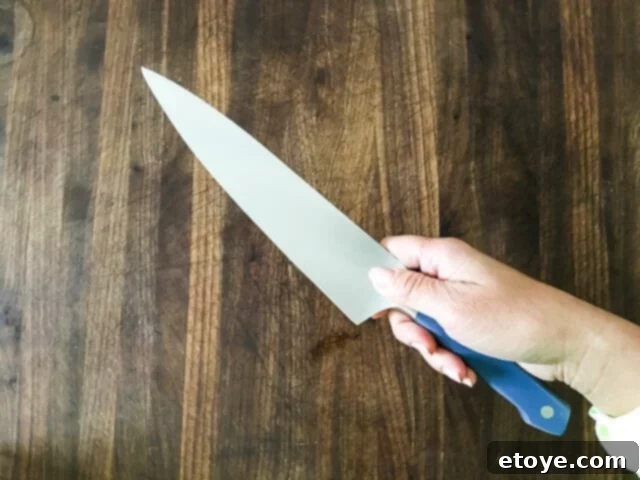
The design of the Misen Chef’s Knife handle is truly exceptional. Its gently sloped bolster – the critical transition point between the handle and the blade – is meticulously crafted to cradle the thumb and forefinger comfortably in the classic pinch grip. This thoughtful contouring ensures that your hand naturally finds its ideal position, minimizing strain and maximizing control.

Unlike many knives that feature prominent, angular bolsters or rough edges, the Misen handle is free from any extraneous material or awkward bumps that could cause discomfort or blisters during extended chopping sessions. Whether you’re finely dicing herbs or powering through dense root vegetables, the ergonomic design ensures a pleasant and fatigue-free experience.
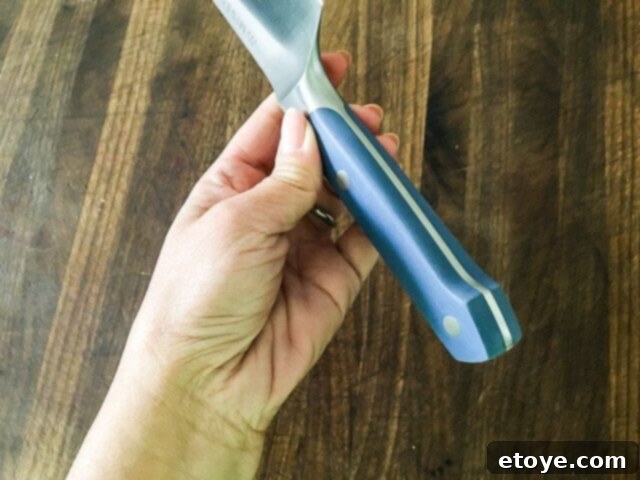
A subtle but significant design detail that becomes apparent with prolonged use is the nuanced shaping of the handle. It’s noticeably rounder towards the blade, gradually becoming more angular towards the back. This isn’t merely an aesthetic choice; the rounded front section facilitates a more secure and comfortable grip, reducing stress on the hand during intricate tasks. The slightly more angular back provides stability and leverage for powerful cuts. This attention to ergonomic detail is a testament to Misen’s commitment to user experience.
Edge Retention and Maintenance: A Practical Perspective
While the Misen Chef’s Knife offers superb comfort, it’s worth noting that its edge retention isn’t quite on par with some ultra-premium knives, like my Wüsthof collection. However, this is a minor trade-off given its overall performance and price point, and importantly, it’s incredibly easy to manage. The Misen blade responds remarkably well to honing with a honing steel. A few quick swipes before each use are all that’s typically needed to realign the edge and restore its sharpness. This routine keeps the knife performing optimally for daily tasks.
For more significant sharpening, I’ve used an electric knife sharpener twice over the past seven months. This frequency is perfectly reasonable for a knife used regularly in a busy kitchen. For those less comfortable with sharpening their own knives, a local butcher often provides professional sharpening services for just a few dollars per blade, ensuring your Misen knives remain in peak condition with minimal effort.
Introducing the Misen Paring Knife: Precision in Your Palm
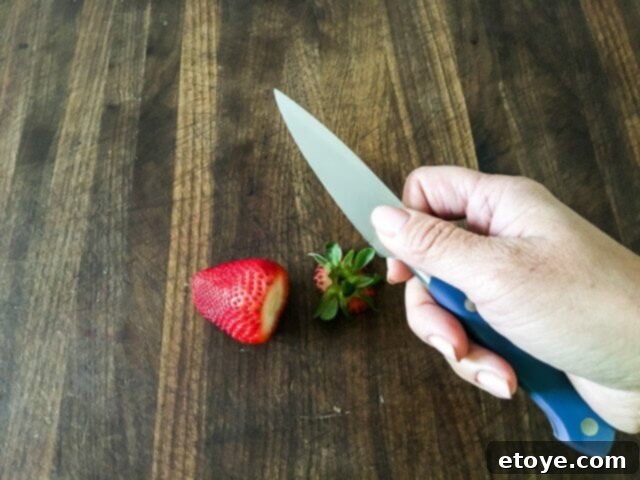
The Misen Paring Knife continues the brand’s tradition of smart design and accessible quality. Priced at an equally affordable $30, it shares the same high-quality Japanese AUS-8 High Carbon Steel and durable handle construction as its larger counterpart. This consistency ensures a familiar and reliable experience across the Misen line, making it an excellent addition to any kitchen.
Like the Chef’s Knife, the Paring Knife features a thoughtfully sloped bolster. While I appreciate this design choice, my typical grip for a paring knife differs significantly from how I hold a chef’s knife. Instead of a pinch grip, I often find myself applying pressure with the crook of my forefinger against the back of the blade for precise control during delicate tasks like peeling, coring, or segmenting small fruits and vegetables.

From a purely comfort-focused perspective for my specific paring knife grip, a slightly flatter area on the spine where the bolster meets the blade might have offered an even more ideal pressure point. However, this is a minor personal preference and does not detract from the overall quality and utility of the knife. Furthermore, Misen’s commitment to inclusivity is evident in the Paring Knife’s ambidextrous design, ensuring comfortable and efficient use for both right-handed and left-handed individuals.
The Unbeatable Misen Price Point: Redefining Kitchen Essentials
Perhaps the most compelling aspect of Misen knives is their incredible value. The set of these two essential knives – the Chef’s Knife and the Paring Knife – can be acquired for just $95. This pricing fundamentally reshapes expectations for high-quality kitchen tools. For many, this duo, paired with a reliable long serrated blade (Misen doesn’t currently offer one, but it’s an easy addition from another brand) for breads and tomatoes, forms the bedrock of a truly functional knife collection. You’ll find that these three knives are all you genuinely need for 99% of your culinary tasks.
Consider the common scenario of a wedding registry or someone furnishing a new kitchen. Often, the default choice is a large, multi-piece knife block set, replete with 7+ knives, kitchen shears, and a bulky wooden block. My advice to a friend recently registering for her wedding perfectly encapsulates the Misen philosophy:
- **Avoid wooden knife blocks:** They are notorious for accumulating dirt and grime within their slots, becoming unhygienic and impossible to clean thoroughly. Furthermore, repeatedly pulling and inserting knives into wooden slots can prematurely dull their edges.
- **Focus on quality over quantity:** Most multi-piece sets include numerous specialized knives that rarely see the light of day. You’ll likely use only a handful of them consistently. It’s far better to invest in 2-4 high-quality knives that you genuinely love and find comfortable to use.
- **Choose shears wisely:** Many kitchen shears in bundled sets have small, uncomfortable handles. Seek out shears with large, rounded, ergonomic handles – you’ll truly appreciate them when performing tasks like spatchcocking a chicken.
- **Opt for magnetic storage:** Instead of a knife block, consider magnetic knife strips. They keep your blades visible, easily accessible, hygienic, and preserve their sharpness by minimizing contact with other surfaces.
Following this advice, my friend enthusiastically added the Misen Knife Set and an electric knife sharpener to her registry. This decision represents a smart investment in essential tools that will genuinely enhance her cooking experience for years to come, without the clutter or unnecessary expense of a sprawling, often underutilized, knife block.
Misen knives are exclusively available for purchase directly from the Misen website, reinforcing their commitment to the direct-to-consumer model that ensures competitive pricing and genuine value.
